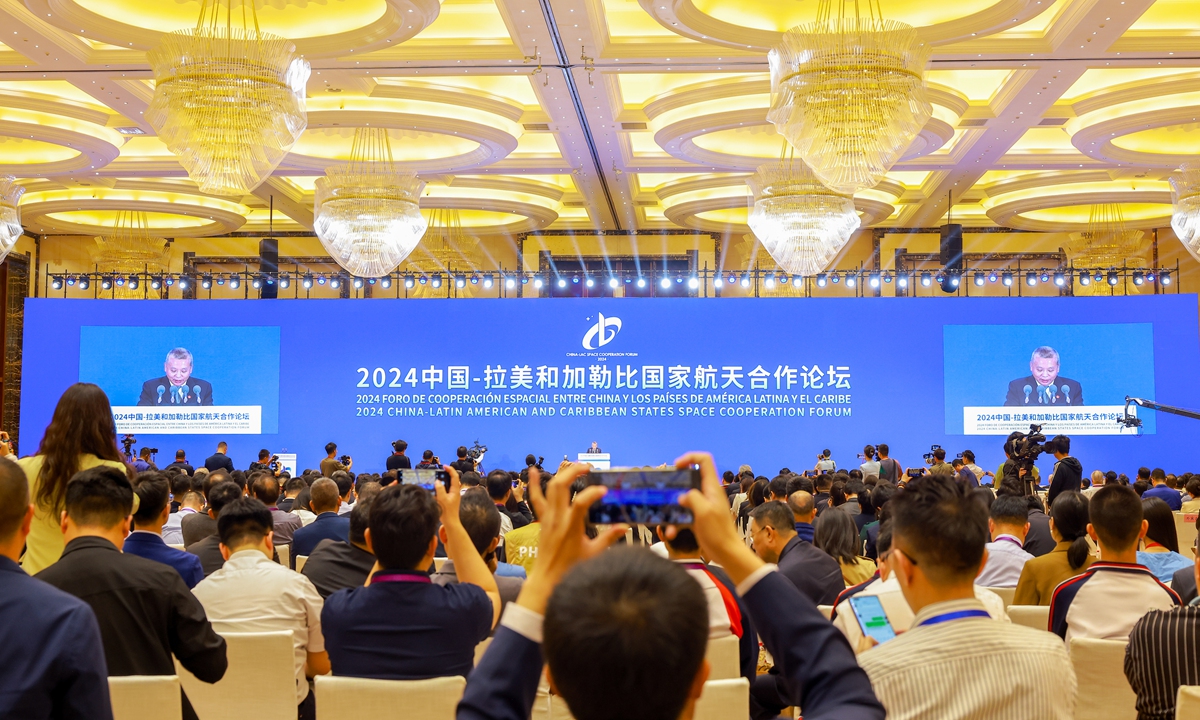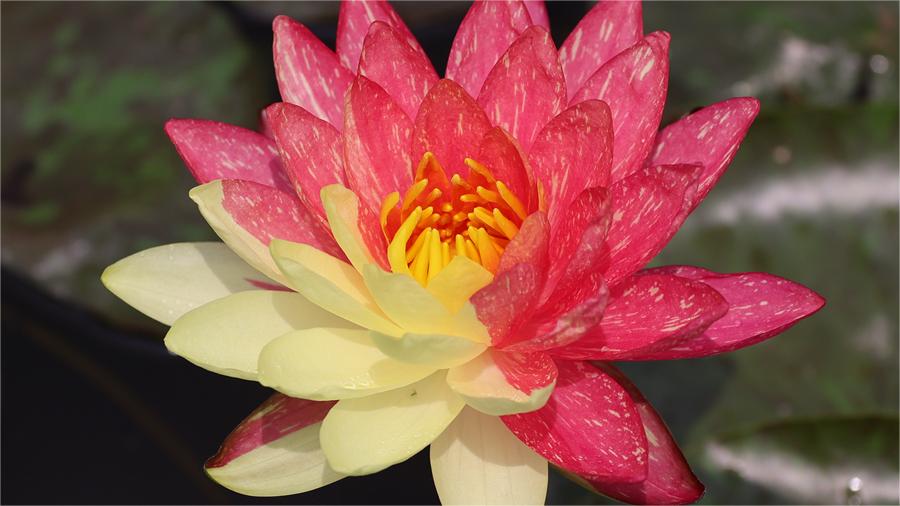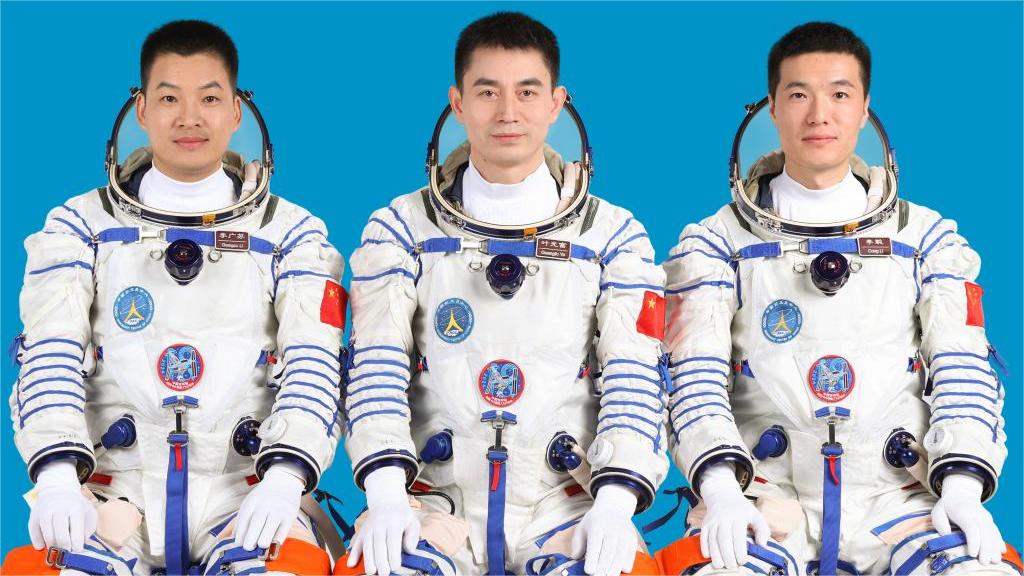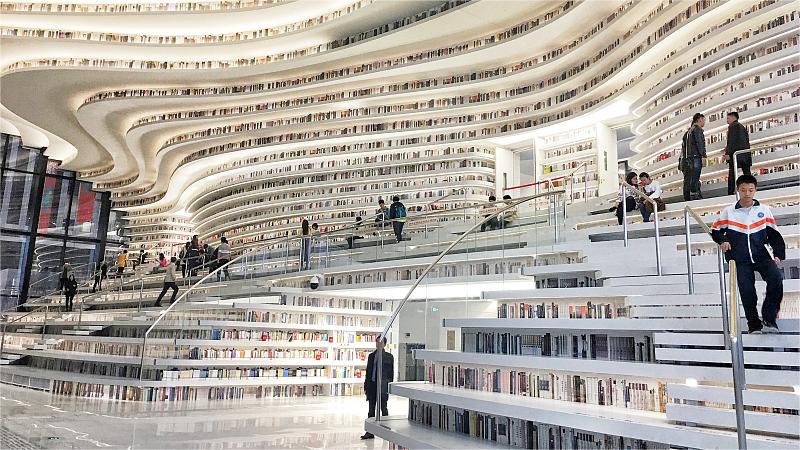China facilitates developing nations to learn about space exploration

China holds the first China-Latin American and Caribbean States Space Cooperation Forum in Wuhan, Central China's Hubei Province on April 24, 2024, marking the Space Day of China. Photo: Deng Xiaoci/GT
Chinese President Xi Jinping, in a congratulatory letter to the first China-Latin American and Caribbean States Space Cooperation Forum on Wednesday, highlighted that China is ready to work with Latin American and Caribbean countries to build a high-level space cooperation partnership, promote space technology to better benefit both peoples, and continue to promote the building of a community of China and the Latin American and Caribbean countries with a shared future.
The event, co-hosted by the China National Space Administration (CNSA) and Hubei provincial government, took place in Wuhan, Hubei Province on Wednesday. The forum holds great significance in inspiring space scientific innovation, deepening international space cooperation, and showcasing the high level of political trust between China and the Latin American, Caribbean countries.
Noting that this year marks the 10th anniversary of the establishment of the China-CELAC (Community of Latin American and Caribbean States) Forum jointly announced by the leaders of the two sides, Xi said that China and Latin American and Caribbean countries have seen prosperous development over the past decade in their cooperation in various fields within the framework of the China-CELAC Forum to usher in a new era featuring equality, mutual benefit, innovation, openness and tangible benefits for the people, the Xinhua News Agency reported.
China is ready to work with Latin American and Caribbean countries to build a high-level space cooperation partnership, promote space technology to better benefit both peoples, and continue to promote the building of a community of China and Latin American and Caribbean countries with a shared future, Xi said.
Only with high-level political trust can the two sides carry out cooperation in the space domain, as it involves a large amount of sensitive areas in national defense technology, Pan Deng, director of the Latin American and Caribbean Region Law Center of the China University of Political Science and Law, told the Global Times on Wednesday.
Pan said that China has mastered a full range of mature space technology, from launching spacecraft, satellite in-orbit operations to applications on the ground, while countries in the Latin America and Caribbean region have the unique geographical advantage of their location in the Earth's western and southern hemisphere, which is crucial for monitoring and tracking space activities as well as their growing need for space power building such as launching commercial satellites.
Therefore, cooperation between China and Latin America in the field of space not only helps enhance the technological innovation capabilities of both sides but also promotes social and economic development. Such cooperation, based on high-level political trust, commercial collaboration, and equal partnership, holds significant and far-reaching implications for enhancing China-Latin America relations, upgrading cooperation, fostering innovative development, and promoting the building of a community of China and Latin American and Caribbean countries with a shared future, he said.
Xi, in the letter, also said that China and Latin American and Caribbean countries have yielded fruitful results in space cooperation in recent years, including new progress in the fields of remote sensing satellites, communication satellites and the deep space station network, which has played an important role in promoting scientific and technological progress, strengthening regional connectivity and improving people's well-being.
Working together for over three decades, China and Brazil have developed six satellites under the China-Brazil Earth Resources Satellite program (CBERS) so far, with the first successful launch in 1999. China helped launch Earth-observing satellites for Venezuela over the years, and helped Bolivia launch the country's first telecom satellite in 2013.

China holds the first China-Latin American and Caribbean States Space Cooperation Forum in Wuhan, Central China's Hubei Province on April 24, 2024, marking the Space Day of China. Photo: Deng Xiaoci/GT
Capacity building for all
Wednesday marked the 2024 Space Day of China with delegates from over 50 countries' aerospace agencies, international organizations, foreign embassies and consulates in China, and research institutions attending the main event in Wuhan.
China designated April 24 as the Space Day of China in 2016 to mark the launch of its first space satellite "Dongfanghong-1" to space on April 24, 1970. According to statistics obtained by the Global Times from the organizers, a series of nearly 500 space-themed activities is being held by relevant departments, universities and associations across the country on April 24 this year.
China revealed on Wednesday more details of international cooperation in its lunar probe programs.
The International Lunar Research Station (ILRS,) a lunar program currently led by the CNSA and Russia's Roscosmos, has added Nicaragua, the Asia-Pacific Space Cooperation Organization (APSCO), and the Arab Union for Astronomy and Space Science as collaborating countries and organizations.
The CNSA announced Wednesday that China will cooperate with these three parties in various aspects such as engineering implementation, operation and application of the ILRS program. According to the CNSA's ILRS Partnership Guidelines, the ILRS aims for peaceful use, equality and mutual benefit, and common development.
Through joint construction with multiple countries, the ILRS will establish a comprehensive scientific experiment facility on the lunar surface and in lunar orbit, capable of long-term autonomous operation, and short-term human involvement, with expandability and maintainability, the Global Times learned from the CNSA on Wednesday.
Aisha Jagirani, director general of the Department of External Relations and Legal Affairs at APSCO, told the Global Times on Wednesday that China's space program is quite impressive compared with other countries that have been working in the development of the technology for so many years. China, in a small time frame period, has done a lot, and most of the work is indigenous and totally done inside China. That is incredible, Jagirani said.
Commenting on APSCO's official joining of the ILRS program, Jagirani hailed that China now brings opportunities to other countries in the Asia-Pacific region, particularly developing countries that do not have much experience in the kind of technology or that cannot work independently.
"So through the platform, the countries have the opportunity to learn about space exploration, what research is involved, what technicalities are involved. We [APSCO] have an agreement with China on the ILRS and that provides an opportunity to the member states including small emerging countries to learn about the dynamics of a space exploration."
"That is something extremely impressive. These kind of opportunities cannot be found anywhere else," she said.
Jagirani elaborated that "the basic idea of joining the ILRS is capacity building, because we understand that not all countries in the Asia-Pacific region have ambitions to send [a] man on the moon, nor maybe have ambition or that much financial capability available to do moon exploration. But through this platform of ILRS, member states could have the capacity-building opportunity, and they're working together to get involved in the work to find out how the whole program is being developed, what research areas are available, when the lunar samples will be brought back to Earth, and how these samples are being researched.
"So it's a great opportunity to focus on training, education and capacity building of the member state so that in future, when they aim to go for space exploration, they already have experience accordingly," she said.
China also announced on Wednesday the Chang'e-7 mission is scheduled to launch around 2026, aiming to survey the lunar south pole's surface environment, lunar soil water ice, and volatile components. It will conduct high-precision exploration and research on lunar topography, composition, and structure.
China's Chang'e-7 mission has selected six international payloads to carry onboard, based on scientific objectives and engineering feasibility, from seven countries and international agencies including Egypt/Bahrain, Italy, Russia, Switzerland, Thailand and the International Lunar Observatory Association.
The Chang'e-7 lander will carry a laser retroreflector array developed by the National Institute for Nuclear Physics in Italy's Frascati National Laboratory to support high-precision measurements on the lunar surface and orbit navigation for orbiters, a lunar dust and electric field detector developed by the Russian Space Research Institute to study the lunar exosphere's dust and plasma environment near the lunar surface, and a lunar astronomical observation telescope developed by the International Lunar Observatory Association to conduct lunar-based observations of the Milky Way, Earth, and the panoramic sky.
The orbiter will carry a lunar material hyperspectral imager jointly developed by the Egyptian Space Agency and the Bahrain National Space Science Agency for analyzing and identifying lunar material and environment, a dual-channel Earth radiation spectrometer developed by the Davos Physical Meteorological Observatory in Switzerland (World Radiation Center) and Shenzhen University for monitoring changes in the Earth's climate system radiation balance from the moon for the first time, and a space weather global monitoring sensor developed by the Ministry of Higher Education, Science, Research, and Innovation of Thailand and the National Astronomical Research Institute of Thailand for early warnings of disturbances caused by solar storms and cosmic radiation.
Photos
Related Stories
- Eyes on China: "A robust Chinese economy benefits all"
- China to hold first space cooperation forum with LatAm, Caribbean countries
- China, LatAm sci-tech cooperation to benefit regional development
- China joins hands with LatAm, Caribbean countries to explore space
- China unveils latest sci-tech challenges in astronautics
- Aerospace exhibition held in Wuhan to celebrate China' Space Day
Copyright © 2024 People's Daily Online. All Rights Reserved.









